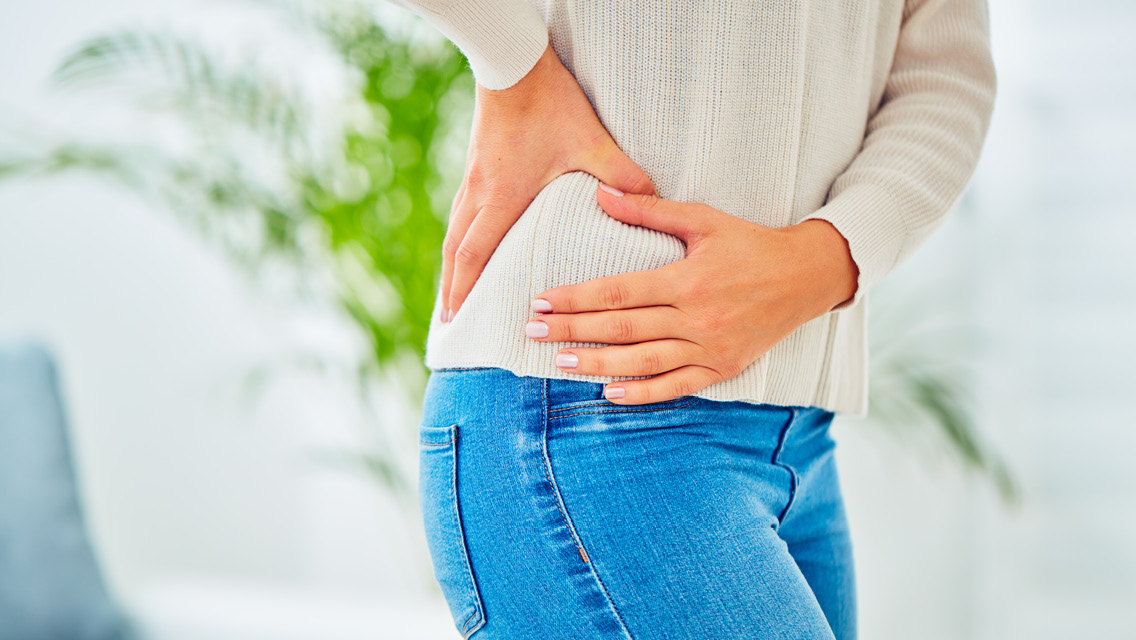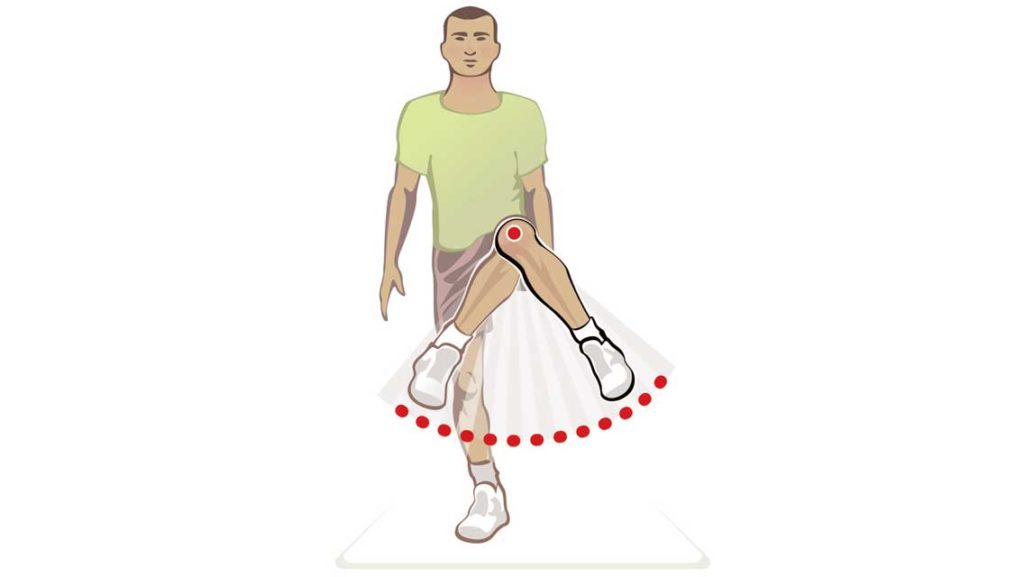After an athletic childhood and years of serious strength training, Steven Schilling, 28, began experiencing lower-back pain during his workouts. Active and pain-free all his life, Schilling sought the help of his former training partner, Mike Robertson, MS, CSCS, a professional trainer and co-owner of Indianapolis Fitness and Strength Training.
After watching him exercise, Robertson concluded that the real problem was not in Schilling’s back, but in his hips. Rather than swinging easily when he walked, Schilling’s legs appeared “glued” into their hip joints, which forced his lower back to move unnaturally. “Whenever Steve bent forward to lift a weight off the floor,” says Robertson, “he would lose the arch in his lower back.” Eventually, this led to back pain.
Schilling’s problem — hip dysfunction masquerading as a back problem — is surprisingly common. “Greater than three-quarters of the back-pain problems that I’ve consulted on are due to underlying hip problems,” says Gray Cook, MSPT, OCS, CSCS, a Danville, Va.–based physical therapist. “If someone comes to me with lower-back or knee issues, they’re saying they also — or even primarily — have a hip problem.”
In other words, if you’re suffering from lower-back pain or knee pain, there’s a good chance the blame can be placed squarely on the joint that sits between them. Fortunately, relief may be just a few simple drills away.
Hip Hitches
To see healthy hips in action, watch a toddler move. As the child plays, his legs move freely. His body never appears to be fighting itself: He squats, bends and sits upright with ease.
Healthy adult hip joints should have the same easy range of motion — albeit with rather more control — allowing you to step in any direction without pain or limitation. A simple test for hip problems is a full, deep squat: Take a shoulder-width stance, toes pointed straight ahead, and drop to a point where your thighs are well past parallel to the floor. The hip joint should flex 120 to 130 degrees, and the knees should remain over or outside the feet as you descend. (Not great with angles? Estimate it by squatting onto a 12-inch box.) Squatting in this manner shouldn’t be a strain, but rather feel easy and natural. Unfortunately, that’s not often the case.
We lose the perfect hip joints we all had as children because we’re no longer exposed to a broad range of different movement patterns, which means our hips essentially become frozen in the flexed-forward position and unable to effectively communicate with the brain. Over time, the hips can become both immobile (unable to move freely) and functionally unstable (unable to balance the body quickly and effectively). “Just as muscles adapt to strength training by getting bigger and stronger,” says ˙ Robertson, “they also adapt to inactivity by shortening and getting weaker.”
But the real problems begin when you try to exercise with dysfunctional hips. Like a big rig stuck in the middle of the highway, immobile hips force everything else to move around them. When a person with immobile hips attempts to run, for example, the lumbar spine twists, extends and flexes unnaturally, causing back pain.
The knee joint also takes a beating from uncoordinated hip action. When the hips function well, the glute muscles prevent the knees from collapsing and rotating inward during movement. But when the glutes become overstretched and inhibited from too much sitting, the knees tend to fall together and turn inward when you walk or descend stairs, leading to pain.
The real source of all these problems, however, often goes undetected because your hips usually feel fine. “People with hip problems never come to me complaining about the hips,” says Cook. “Usually, you’re not aware of your tightest structure.” (See also “Go-To Glutes”.)
Hip Fixes
Some trainers treat hip mobility and stability problems separately, but Cook says they actually have the same solution. “Working on your mobility will enhance your stability,” he says. “The more mobility you have, the more reflex stabilization you will have.” And the less your back and knees will bug you.
A good exercise program will mobilize the hips in all three planes of motion: the sagittal plane (front to back), the frontal plane (side to side) and the transverse plane (rotational on an axis). You can perform the four simple exercises at right as part of your warm-up anytime you’re working on your lower body. You can also add resistance to the second two and perform them up to three times a week as part of an intense lower-body strength-and-conditioning routine. Expect changes in the way you move within a few sessions and substantial improvement in a few weeks.
Cook Hip Lift

- Lie on your back with your feet flat on the floor, knees bent 90 degrees.
- Place a tennis ball in the crook of your left hip and hold it there by squeezing your left knee toward your chest. Keep your hands on the mat.
- Press down through the heel of your right foot and lift the hips off the floor, then lower under control (your range of motion will be fairly small).
- Repeat on the opposite side, performing two to three sets of 15 to 20 repetitions per leg.
Standing Hip Pendulums
- Standing upright, hold on to something stable for balance with your right hand, if necessary.
- Lift your left knee in front of you until your hip and knee are both bent 90 degrees.
- Maintaining upright posture and keeping your thigh in the same position throughout, swing your lower leg easily from side to side, like a pendulum. Perform the exercise at a “fast and floppy” tempo for about five seconds and repeat with the knee pointed out to your left.
- Repeat on the right side.
Warrior Split Squats

- Stand with your feet approximately two shoulder-widths apart. Rotate your hips toward your left foot, and turn that foot so it’s facing forward. Shift your right foot so it’s facing 45 degrees outward. This is your start position.
- Keeping your torso upright and your right leg extended, lunge over the left knee. Push through the heel of the left foot to return to the starting position.
- Perform 12 to 15 repetitions and repeat on the right side.
Make it harder: hold dumbbells by your sides.
Limited-Range Dead Lifts

- Place a pair of dumbbells on two 12-inch aerobic steps placed 18 inches apart. Stand between the steps, hinge forward at the waist and bend the knees slightly, maintaining a slight arch in your lower back.
- Grasp the dumbbells firmly, look forward, and drive through both heels until you are upright, keeping the natural arch in the lower back throughout.
- Advance the movement by using a shorter step, adding weight, or performing it on one leg.
- Perform three sets of five to eight reps.
The Sacroiliac (SI) Joint
As its name suggests, the SI joint is the intersection point between the sacrum — the bony structure that encapsulates the tailbone — and the ilia, or hip bones. It’s a joint by definition, but it isn’t designed to move much, says Eric Cobb, DC, creator of Z-Health (www.zhealth.net). “If you’re in a car accident, the pelvis will often fracture in multiple places before the SI joint will tear. That’s how strong and stable it is.”
And yet, pain and inflammation at the SI joint are fairly common. Once again, dysfunction in the hip joint is often to blame. Like the back and knees, the SI joint is another place the body seeks compensatory movement when the hips don’t move properly. “A lot of the problems with the SI joint occur because of the lack of differentiation between the hip and pelvis — which means people aren’t able to move their hip joints while using the core musculature to stabilize the pelvis,” says Cobb. “
If you’re having SI joint problems, you either had a really large baby or you’re doing something wrong,” says Gray Cook, MSPT, OCS, CSCS, a Danville, Va.–based physical therapist. “You’ve been running or lifting more than you should, or you’ve developed one-side dominance from too much tennis or golf, and it’s led to some imbalance in the body. Perpetuate that long enough and you start to put extra stress on the ligaments of the SI joint.”
So if this nearly indestructible joint starts to bother you — in the form of pain in the groin, sharp lower-back pain, or pain that increases while sitting — you have probably been exercising too long and hard, or over-taxing one side of the body at the expense of the other. If that’s the case, back off for a while to regroup. When you return to your workouts, focus on functional core strength, find ways to strengthen and develop your non-dominant side, and start including the hip mobility exercises we recommend.
This article originally appeared as “Hip Check”.





This Post Has 0 Comments